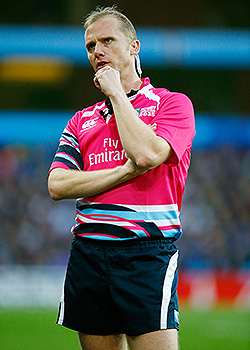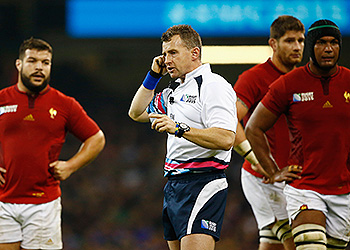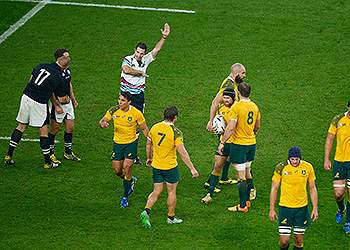The TMO and his Hawk-Eye
There was also an innovation – the use of Hawk-Eye for simultaneous multiple angle replays in real-time and slow motion. It also allowed for zooming in and could be used by match officials and in disciplinary inquiries.
 The Hawk-Eye by the way has nothing to do with the apparatus which makes referees look as if they are auditioning for the role of Richard III. That is a refcam (short for referee's camera) which occasionally gets used at scrums and in referee's conversation – very occasionally, occasionally enough not to justify referee disfigurement.
The Hawk-Eye by the way has nothing to do with the apparatus which makes referees look as if they are auditioning for the role of Richard III. That is a refcam (short for referee's camera) which occasionally gets used at scrums and in referee's conversation – very occasionally, occasionally enough not to justify referee disfigurement.
The Hawk-Eye, which was tried out well before the World Cup, does not alter the referee's way of communicating with the TMO, in other words with the TMO protocol.
It does not add to the protocol in any way and the reduced application of the TMO protocol for the World Cup came back to bite in the last few minutes of the quarter-final between Australia and Scotland.
Hawk-Eye does not replace the broadcaster, It in the case of the World Cup. What Hawk-Eye does is provide and extra set of eyes, an adaptation of what the cameras show, for example enlarged focus when there is a bundle of players over the line or a split screen at a potential try when touch is involved.
Hawk-Eye is used in several other sports, including Rugby League, Aussie Rules, athletics, horseracing, baseball soccer, badminton and even volleyball.
 The provision of cameras for World Cup matches is great – 36 at Twickenham. There are fewer at smaller grounds but still+ more than the norm. In the 40 pool matches so far, the TMO has been used an average of 2,9 times per match and the success rate is well over 90% correct. It is not 100% only because of some debatable instances.
The provision of cameras for World Cup matches is great – 36 at Twickenham. There are fewer at smaller grounds but still+ more than the norm. In the 40 pool matches so far, the TMO has been used an average of 2,9 times per match and the success rate is well over 90% correct. It is not 100% only because of some debatable instances.
The TMO is encouraged to suggest problems when he says them. If he sees foul play, for example, he hits the 'panic button' to alert a technician to bookmark the incident. The incident can be reviewed while the game goes on and eliminated if there is no 'clear and obvious' foul play.
The TMO can also get into the referee's ear, saying 'Check, check, TMO.' Hawk-Eye is especially used for foul play and will lead the replays whereas for the try/no try decision the broadcaster leads.
The Hawk-Eye is also used by medics when there is a suspected injury, especially head injury, to a player.
World Cup has done its best to make it foolproof and at great expense but, it seems, it did not do enough.
 In that last, notorious decision in the Australia-Scotland game it had denied the referee the option of consulting the TMO. It was a difficult situation, cluttered by several desperate players – an ideal situation for consulting the TMO. But the TMO protocol for the World Cup did not allow it.
In that last, notorious decision in the Australia-Scotland game it had denied the referee the option of consulting the TMO. It was a difficult situation, cluttered by several desperate players – an ideal situation for consulting the TMO. But the TMO protocol for the World Cup did not allow it.
The referee was allowed to consult the TMO in the case of a try and in the case of foul play. There was no try involved here and no foul play, just an extremely difficult position.
In some parts of the world, including South Africa which is where Craig Joubert referees most, the TMO protocol in use there would have allowed him to consult the TMO. That tells you that a protocol is not a part of rugby's natural law. It is an artificial thing, not part of the spirit of the game.
Having hamstrung their referee, one of the four referees chosen out of thousands in the world to referee a World Cup quarterfinal, they announced that he had erred. They did not go through every World Cup match to say where the referee erred but they did it in this case, throwing fuel onto raging Scottish wrath.
The truth about sport is that it is a human activity. As a human activity it is liable to error. In fact error is at the essence of sport. Without it sport would not be possible.
We try for perfection, as we are obliged to do, even though we know that it is unattainable. The use of the TMO is a step in the right direction on the path to perfection.
By Paul Dobson















































